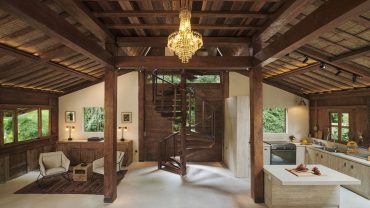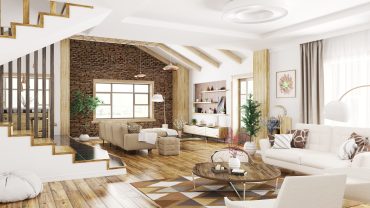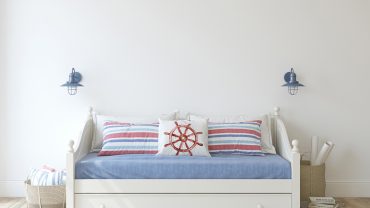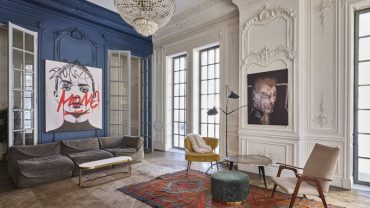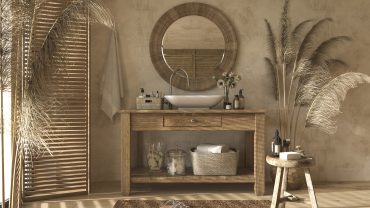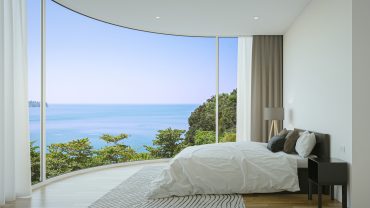Bauhaus was an art school – one of the most influential in history – which left an indelible mark on the world of architecture and interior design. Originating in Germany in the early twentieth century, Bauhaus, a compound of bauen – to build – and haus – house – emphasises practicality and simplicity in construction and design.
At the core of Bauhaus interior decor lies a profound belief in the principle of ‘form follows function’, the idea that the purpose of an object should be the starting point for its design – a chair or a teapot – rather than focusing on design first and purpose second. This ethos, for Bauhaus at least, steers away from superfluous decoration, focusing instead on clean lines, geometric shapes, and a harmonious blend of colour, light, and space.
According to Bauhaus design, interior spaces are reduced to basic elements and indeed the Bauhaus movement was a trailblazer for minimalism, significantly impacting various aspects of modern living, from open-plan spaces and integrated kitchens to collapsible chairs and modular furniture.
The simplicity of Bauhaus designs facilitated their replication and efficient production through mass manufacturing and industrial methods. Consequently, Bauhaus played a pivotal role in transforming design into a more democratic and universally accessible art form.
Sleek, simple, functional and beautiful. This is your guide to Bauhaus interior design.
The History of Bauhaus Interior Decor

Walter Gropius. (Credit: ullstein bild Dtl. / Contributor via Getty Images)
Bauhaus owes its inception and proliferation to a group of avant-garde architects, designers, and artists led by Walter Gropius, who founded the Bauhaus School in the central German city of Weimar in 1919. This educational institution was a melting pot of innovative ideas, where creators like Ludwig Mies van der Rohe, Marianne Brandt, Paul Klee, Gunta Stölzl, Marcel Breuer, and Wassily Kandinsky collaborated and influenced the evolution of modern design.
Despite its short lifespan, with the school being forcibly closed in 1933, the impact of Bauhaus design, interior space and externally, is profound and enduring. It paved the way for many modernist design movements and remains a foundational influence in contemporary design practices.
The Principles of Bauhaus Interior Design

An interior of a spacious loft conversion, decorated in a Bauhaus style. (Credit: Westend61 via Getty Images)
The style principles of Bauhaus interior design are characterised by functionality, practicality, simplicity and usefulness. Furniture and decorative items are distinguished by their slender, streamlined forms and absence of ornate details.
The Bauhaus movement favoured materials such as steel, glass, plywood and plastic chosen for their modernity and efficiency, promoting an industrial yet elegant look. The colour palette typically revolves around primary colours, supplemented by neutrals and monochromatic tones, to create a bold yet balanced visual appeal. Bauhaus interior style also emphasises the importance of integrating art and craftsmanship, resulting in pieces that are not just functional but also artistically significant.
Indeed some of the most emblematic and iconic furniture pieces of the twentieth century are Bauhaus designs.
Designed in the mid-1920s by Marcel Breuer, the tubular steel Wassily Chair was inspired by the lightweight frames of bicycles. Marianne Brandt’s geometric tea infuser, Josef Hartwig’s chess set, and the MT8 Lamp by William Wagenfeld and Carl Jakob Jucker are true design classics.
Perhaps the most famous of all is the Brno Chair designed by Ludwig Mies van der Rohe. It has become the template for reducing design to its most basic element, the cornerstone of Bauhaus interior decor.
The Bauhaus Colour Palette

Modern Bauhaus bedroom interior. (Credit: tulcarion via Getty Images)
The Bauhaus colour palette is notable for its emphasis on simplicity and functionality, reflecting the movement’s overall design principles. It generally includes three categories of colours –
Primary
Red, blue, and yellow are the mainstay of the Bauhaus palette. These bold, pure colours were favoured for their simplicity and ability to create strong visual contrasts, most notably in Josef Albers’ Nesting Tables. They were often used in their most saturated forms to make a statement in designs.
Neutral
Shades of white, black, and grey are also prominent in Bauhaus designs. These neutral tones were used to create a balanced and cohesive look, often serving as a backdrop to highlight the vibrancy of the primary colours.
Functional
Colours derived from the materials used in Bauhaus interior decor, such as the metallic tones of steel or the earthy hues of wood, were also integral. These colours were often used in their natural state, reflecting the Bauhaus commitment to authenticity and functionality in materials.
Ultimately, the Bauhaus palette is characterised by its restraint and strategic use of colour to create visual impact, functionality, and harmony in design.
Bauhaus: Shaping the Future of Design

A luxurious living space, utilising Bauhaus interior design. (Credit: tulcarion via Getty Images)
The answer to the question ‘what is Bauhaus interior design’ is multifaceted. Understanding Bauhaus interior style is not merely about recognising its aesthetic or historical significance. It’s about appreciating a philosophy that intertwines practicality with beauty, as well as understanding that mass-produced items possess artistic value.
Not only did Bauhaus revolutionise interior design, it reformulated the way art and design are taught, with many contemporary art schools still drawing on its methods and principles. It also had a profound influence on graphic design and typography, advocating for simplicity and readability. This approach revolutionised and set new standards in advertising and digital design
The Bauhaus movement challenged the status quo and carried a powerful and cultural ideological message. It advocated for a democratisation of design that was accessible and functional for all, not just the elite. Today, Bauhaus interior decor continues to inspire designers and architects worldwide, serving as a reminder that great design can be timeless, transcending both trends and generations.





